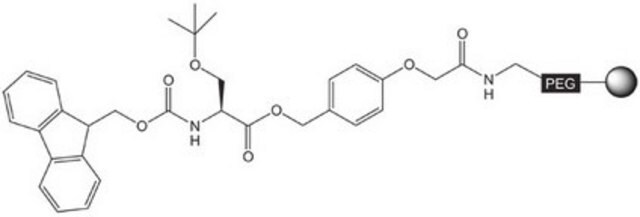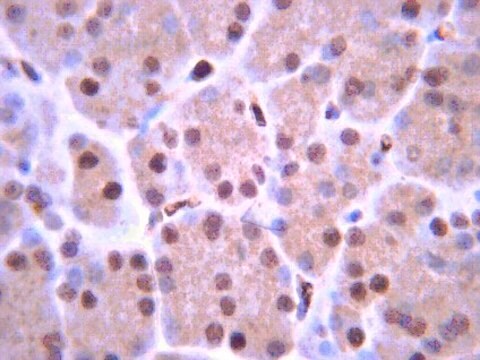추천 제품
생물학적 소스
mouse
Quality Level
결합
unconjugated
항체 형태
purified antibody
항체 생산 유형
primary antibodies
클론
7D11, monoclonal
분자량
calculated mol wt 97.44 kDa
observed mol wt ~43 kDa
정제법
using protein G
종 반응성
mouse, human
종 반응성(상동성에 의해 예측)
horse, porcine, bovine, feline, rat, Xenopus, canine
포장
antibody small pack of 100 μg
기술
immunocytochemistry: suitable
immunofluorescence: suitable
western blot: suitable
동형
IgG1
에피토프 서열
C-terminal
단백질 ID 수납 번호
UniProt 수납 번호
배송 상태
ambient
타겟 번역 후 변형
unmodified
유전자 정보
mouse ... Ccr9(12769)
일반 설명
Dystroglycan (UniProt: Q14118; also known as Dystrophin-associated glycoprotein 1) is encoded by the DAG1 gene (Gene ID: 1605) in human. The dystroglycan complex is involved in a number of processes including laminin and basement membrane assembly, sarcolemmal stability, cell survival, peripheral nerve myelination, nodal structure, cell migration, and epithelial polarization. It also serves as an adhesion molecule and links the extracellular matrix to the intracellular actin cytoskeleton. Its expression is reported in a variety of fetal and adult tissues. It is synthesized with a signal peptide (aa 1-29) that is subsequently cleaved off to generate the mature protein that is further autolytically cleaved (between 653-654) to produce -dystroglycan (aa 30-653) and β-dystroglycan (aa 654-895). -dystroglycan is an extracellular peripheral glycoprotein that binds to several extracellular matrix and synaptic proteins such as laminin-2 and 5, agrin, neurexin, and pikachurin. It is heavily O-glycosylated, which comprises of up to two thirds of its mass and the carbohydrate composition differs depending on tissue type. It is reported that its O-mannosyl glycosylation is required for its ligand- binding functions. It plays important roles in the deposition, organization, and stability of basement membranes. β-dystroglycan is a single-pass type 1 transmembrane protein with its cytoplasmic tail bound to utrophin or dystrophin. It plays important roles in connecting the extracellular matrix to the cytoskeleton and serves as a cell adhesion receptor in both muscle and non-muscle tissues. In the cell, β-dystroglycan binds to dystrophin that is linked to actin cytoskeleton. Hence, /β- dystroglycans act as a molecular axis connecting extracellular matrix with the cytoskeleton across the plasma membrane. Defects in O-mannosyl glycan have been linked to various congenital muscular dystrophies caused by aberrant -dystroglycan glycosylation. (Ref.: Alonso-Rangel, L., et al. (2017). Life Sci. 182; 1-9; Yoon, JH., et al. (2012). J Proteome Res. 11(9); 4413-4424).
특이성
Clone 7D11 is a mouse monoclonal antibody that detects β-Dystroglycan. It targets an epitope within 15 amino acids from the C-terminal region.
면역원
A linear peptide corresponding to 15 amino acids from the C-terminal region of human β-Dystroglycan.
애플리케이션
Quality Control Testing
Evaluated by Western Blotting in HeLa cell lysates.
Western Blotting Analysis: A 1:1,000 dilution of this antibody detected β-Dystroglycan in HeLa cell lysates.
Tested Applications
Immunocytochemistry Analysis: A representative lot detected β-Dystroglycan in Immunocytochemistry applications (Azuara-Medina, P.M., et al. (2019). Cell Death Dis. 10(3):196).
Western Blotting Analysis: A representative lot detected β-Dystroglycan in Western Blotting applications (Sherman, D.L., et al. (2001). Neuron. 30(3):677-87; Acharyya, S., et al. (2005). Cancer Cell. 8(5):421-32; Azuara-Medina, P.M., et al. (2019). Cell Death Dis. 10(3):196; Alonso-Rangel, L., et al. (2017). Life Sci. 182:1-9).
Immunofluorescence Analysis: A representative lot detected β-Dystroglycan in Immunofluorescence applications (Sherman, D.L., et al. (2001). Neuron. 30(3):677-87; Acharyya, S., et al. (2005). Cancer Cell. 8(5):421-32; Azuara-Medina, P.M., et al. (2019). Cell Death Dis.10(3):196; Moretti, A., et al. (2020). Nat Med. 26(2):207-214).
Note: Actual optimal working dilutions must be determined by end user as specimens, and experimental conditions may vary with the end user
Evaluated by Western Blotting in HeLa cell lysates.
Western Blotting Analysis: A 1:1,000 dilution of this antibody detected β-Dystroglycan in HeLa cell lysates.
Tested Applications
Immunocytochemistry Analysis: A representative lot detected β-Dystroglycan in Immunocytochemistry applications (Azuara-Medina, P.M., et al. (2019). Cell Death Dis. 10(3):196).
Western Blotting Analysis: A representative lot detected β-Dystroglycan in Western Blotting applications (Sherman, D.L., et al. (2001). Neuron. 30(3):677-87; Acharyya, S., et al. (2005). Cancer Cell. 8(5):421-32; Azuara-Medina, P.M., et al. (2019). Cell Death Dis. 10(3):196; Alonso-Rangel, L., et al. (2017). Life Sci. 182:1-9).
Immunofluorescence Analysis: A representative lot detected β-Dystroglycan in Immunofluorescence applications (Sherman, D.L., et al. (2001). Neuron. 30(3):677-87; Acharyya, S., et al. (2005). Cancer Cell. 8(5):421-32; Azuara-Medina, P.M., et al. (2019). Cell Death Dis.10(3):196; Moretti, A., et al. (2020). Nat Med. 26(2):207-214).
Note: Actual optimal working dilutions must be determined by end user as specimens, and experimental conditions may vary with the end user
Anti-β-Dystroglycan, clone 7D11, Cat. No. MABT1546, is a mouse monoclonal antibody that detects β-Dystroglycan and is tested for use in Immunocytochemistry, Immunofluorescence, and Western Blotting.
물리적 형태
Purified mouse monoclonal antibody IgG1 in buffer containing 0.1 M Tris-Glycine (pH 7.4), 150 mM NaCl with 0.05% sodium azide.
저장 및 안정성
Recommended storage: +2°C to +8°C.
기타 정보
Concentration: Please refer to the Certificate of Analysis for the lot-specific concentration.
면책조항
Unless otherwise stated in our catalog or other company documentation accompanying the product(s), our products are intended for research use only and are not to be used for any other purpose, which includes but is not limited to, unauthorized commercial uses, in vitro diagnostic uses, ex vivo or in vivo therapeutic uses or any type of consumption or application to humans or animals.
적합한 제품을 찾을 수 없으신가요?
당사의 제품 선택기 도구.을(를) 시도해 보세요.
Storage Class Code
12 - Non Combustible Liquids
WGK
WGK 1
시험 성적서(COA)
제품의 로트/배치 번호를 입력하여 시험 성적서(COA)을 검색하십시오. 로트 및 배치 번호는 제품 라벨에 있는 ‘로트’ 또는 ‘배치’라는 용어 뒤에서 찾을 수 있습니다.
자사의 과학자팀은 생명 과학, 재료 과학, 화학 합성, 크로마토그래피, 분석 및 기타 많은 영역을 포함한 모든 과학 분야에 경험이 있습니다..
고객지원팀으로 연락바랍니다.






